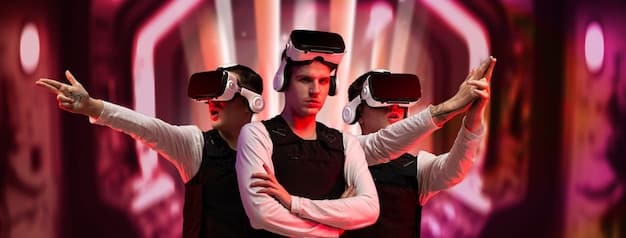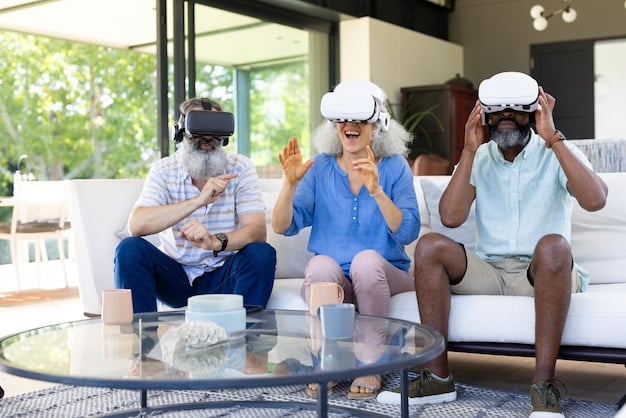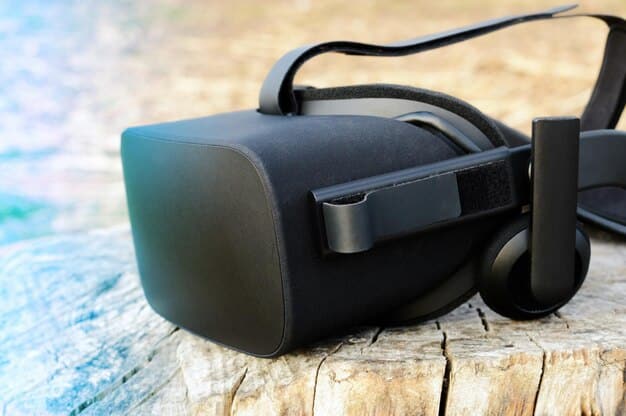VR’s Red Carpet Revolution: Future of Film Festivals

Through immersive narratives and democratized access, virtual reality is fundamentally reshaping how film festivals operate, broadening their reach and redefining audience engagement with cinematic experiences.
The traditional red carpet experience, synonymous with glamour and exclusivity, is undergoing a profound transformation. As technology advances, particularly in the realm of virtual reality, film festivals are finding innovative ways to expand their reach, engage audiences, and showcase cinematic art. The Future of Film Festivals: How Virtual Reality Is Changing the Red Carpet Experience explores this paradigm shift, delving into how immersive technologies are not just altering but indeed redefining the very essence of film celebration.
The Dawn of Virtual Immersion in Cinematic Showcases
Film festivals have historically been physical gatherings, vibrant hubs where filmmakers, critics, and enthusiasts converge. However, the advent of virtual reality (VR) is increasingly blurring the lines between physical and digital spaces, ushering in a new era of accessibility and engagement for these prestigious events.
This evolving landscape presents both exciting opportunities and complex challenges. Curators are exploring how to integrate VR not just as a viewing platform, but as a medium for storytelling, a tool for interactive experiences, and a gateway to a global audience previously constrained by geographical and logistical barriers.
Redefining Attendance: Beyond Physical Boundaries
A primary impact of VR on film festivals is the radical alteration of attendance metrics. No longer are festivals limited to those who can afford travel and accommodation, or who live in major metropolitan areas where such events typically occur. VR opens the door to a truly global audience.
- Global Accessibility: Viewers from any corner of the world can “attend” screenings and interact with festival content.
- Reduced Carbon Footprint: Virtual attendance lessens the environmental impact associated with mass travel.
- Increased Inclusivity: Individuals with mobility issues or other limitations can participate fully in the festival experience.
From Passive Viewing to Active Participation
Beyond simple accessibility, VR transforms the passive act of watching a film into an active, immersive experience. Attendees can navigate virtual lounges, participate in Q&A sessions with directors, and even experience films with a heightened sense of presence not possible on a flat screen.
This deepened level of engagement holds significant promise for filmmakers eager to push the boundaries of narrative and interaction. It allows for a more profound connection between the audience and the artistic work, moving beyond traditional cinematic conventions into unexplored territories of storytelling.
The integration of virtual reality is fundamentally reshaping the participation dynamic at film festivals, allowing for unprecedented levels of inclusion and interaction. This shift is not merely technological but cultural, promising a more democratic and globally connected future for the cinematic arts.
VR as a New Medium for Storytelling and Exhibition
Virtual reality is not just changing how films are exhibited; it is profoundly influencing the art of filmmaking itself. Directors and artists are increasingly exploring VR as a robust medium for storytelling, one that offers unique narrative possibilities and demands a rethinking of traditional cinematic language.
This new frontier challenges established conventions, pushing creators to craft experiences that are not only visually captivating but also deeply immersive and interactive. The shift from a passive screen to an encompassing virtual environment opens up narratives that can be explored from multiple perspectives, allowing the viewer to truly inhabit the story world.
Breaking Traditional Narrative Structures
Traditional filmmaking guides the viewer’s eye, controlling focus and perspective. In VR, however, the audience often has agency, free to look around and potentially interact with their environment. This freedom necessitates a new approach to narrative construction.
- Non-linear Exploration: Stories can unfold based on viewer choices or spatial exploration, rather than a fixed sequence.
- Spatial Storytelling: Narrative elements are embedded within the virtual environment, discovered by the user’s movement and gaze.
- Embodied Perspectives: Viewers can experience a story directly from a character’s viewpoint, enhancing empathy and connection.
Dedicated VR Categories and Showcases
Recognizing the unique potential of VR, many leading film festivals have already inaugurated dedicated categories and showcases for immersive content. Events like the Venice VR Expanded at the Venice Film Festival and Tribeca Immersive at the Tribeca Film Festival are pioneering platforms for this emerging art form.
These dedicated sections highlight VR films, interactive experiences, and even performance art that leverage the medium’s distinct capabilities. They serve as crucial proving grounds for artists experimenting with VR, offering invaluable feedback and exposure within the broader film community.
The embrace of VR as a legitimate and powerful storytelling medium within the festival circuit signals a significant evolution in how cinema is defined and experienced. It promises a future where stories are not just watched, but deeply felt and actively explored, pushing the boundaries of artistic expression.
The Democratization of Access and Content Discovery
One of the most transformative aspects of virtual reality in the context of film festivals is its unparalleled capacity for democratization. Gone are the days when access to independent and international cinema was largely restricted to those living near major cultural hubs or with the means to travel.
VR platforms are dismantling these barriers, creating a more equitable playing field for both content creators and audiences. This shift extends beyond mere accessibility, also influencing how new talent and diverse voices are discovered and celebrated within the industry.
Beyond Geographic and Economic Barriers
Historically, attending a major film festival involved significant financial and logistical commitments. VR removes these obstacles, allowing anyone with a headset and an internet connection to participate.
This newfound accessibility fosters a more diverse and engaged audience base while also providing a crucial outlet for filmmakers from regions not typically included in the mainstream festival circuit. It allows for a truly grassroots approach to cinema, where talent can emerge from unexpected places.
Curated Virtual Environments
Beyond simply streaming films, VR platforms can create sophisticated virtual environments that replicate and even enhance the festival experience. Imagine walking through a virtual rendition of the Cannes Palais des Festivals, browsing digital art installations, or attending a press conference avatar-to-avatar.
These curated spaces, complete with digital lounges and interactive exhibits, foster a sense of community and connection that goes beyond simple viewership. They allow for serendipitous encounters and networking opportunities that mirror the real-world festival experience, but on a global scale.
The democratization enabled by VR extends to content discovery itself. With virtual platforms, niche genres, experimental films, and works from emerging artists can reach a wider, more diverse audience. This expanded reach helps counter the dominance of mainstream productions, fostering a richer and more varied cinematic landscape for all.
Challenges and Considerations for VR Integration
While the prospects of virtual reality transforming film festivals are immensely exciting, its full integration is not without significant challenges. Overcoming these hurdles will be crucial for VR to truly fulfill its potential and become a staple of the global film circuit.
These challenges span technological, financial, and experiential domains, demanding innovative solutions and collaborative efforts from developers, festival organizers, and filmmakers alike. Addressing them will ensure that the immersive experience remains accessible, high-quality, and equitable for all participants.

Technological Hurdles and Infrastructure
The primary barrier to widespread VR adoption remains the technology itself. High-quality VR headsets can be expensive, limiting access for many potential attendees. Furthermore, the varying specifications of devices can lead to inconsistencies in the viewing experience.
- Hardware Accessibility: Cost and availability of high-end VR headsets remain a significant hurdle for mass adoption.
- Bandwidth Requirements: Streaming high-fidelity VR content demands robust internet infrastructure, which is not universally available.
- Software Compatibility: Ensuring content runs smoothly across different VR platforms and devices can be complex for developers.
Ensuring Accessibility and Inclusion
While VR promises greater accessibility in some ways, it also introduces new forms of exclusion. Not everyone has access to the internet, let alone high-speed connections, or devices capable of running sophisticated VR experiences. There are also concerns about motion sickness and digital fatigue.
Festival organizers must consider strategies to bridge this digital divide, such as offering public VR viewing stations or partnering with libraries and community centers. Designing inclusive VR experiences that minimize discomfort and cater to diverse user needs will be paramount.
Maintaining the “Red Carpet” Prestige
A significant challenge lies in translating the unique allure and prestige of the physical red carpet experience into a virtual realm. The spontaneous networking, the buzz of premiere nights, and the hands-on interaction with creators are difficult to replicate digitally.
While virtual avatars and digital lounges can mimic some aspects, creating genuine human connection and the feeling of being part of an exclusive event requires inventive solutions. The goal should be to enhance, rather than replace, the magic of in-person gatherings when they are possible.
Ultimately, a successful integration of VR into film festivals will depend on a nuanced approach that leverages technological advancements while thoughtfully addressing issues of access, quality, and the preservation of the unique human elements that define these cherished events.
Hybrid Models: Blending Physical and Virtual Experiences
Rather than a complete replacement of traditional festivals, the future likely lies in hybrid models that ingeniously blend physical and virtual components. This approach promises to harness the strengths of both formats, creating a richer, more expansive, and resilient festival ecosystem.
Hybrid models offer a flexible framework, allowing festivals to maintain their local presence and unique ambiance while simultaneously extending their reach and impact globally. This adaptability is particularly valuable in an unpredictable world, ensuring continuity and broader participation.
Maximizing Reach Through Dual Presence
A hybrid festival could feature a core in-person event for premieres, industry networking, and local audiences, complemented by a robust virtual platform for global viewership and immersive content showcase. This dual presence caters to diverse preferences and capabilities.
For attendees, it means having the choice between a full in-person experience, a fully virtual one, or a combination of both. For filmmakers, it means expanded audience reach and increased visibility, regardless of geographical limitations.
Enhanced Engagement Opportunities
The virtual component of a hybrid festival can offer unique interactive experiences not feasible in a purely physical setting. Imagine attending a screening in a virtual theater, then instantly teleporting to a Q&A session with the director’s avatar, followed by a networking mixer in a metaverse lounge.
These virtual spaces can facilitate structured and spontaneous interactions, fostering connection among participants who might otherwise never meet. They also provide platforms for digital art installations, virtual reality film premieres, and interactive exhibits that transcend the physical space.
- Virtual Q&As: Direct interaction with filmmakers regardless of physical location.
- Networking Hubs: Digital lounges for industry professionals and enthusiasts to connect.
- Exclusive VR Content: Showcasing immersive films and experiences unique to the virtual platform.
Hybrid models represent a pragmatic and forward-thinking evolution for film festivals. They ensure that the heritage and magic of physical gatherings endure, while simultaneously embracing technological innovation to democratize access, amplify reach, and create truly unforgettable cinematic events for a global audience.
The Economic and Creative Impact on the Film Industry
The integration of virtual reality into film festivals is not just a technological shift; it carries profound economic and creative implications for the broader film industry. This evolving landscape presents new revenue streams, redefines audience engagement, and challenges filmmakers to innovate their craft.
Understanding these impacts is crucial for stakeholders – from independent filmmakers to major studios – as they navigate the burgeoning market for immersive content and the evolving nature of film distribution and exhibition.

New Revenue Streams and Business Models
Virtual festivals open up novel commercial avenues. While ticket sales for physical events are capped by venue capacity, virtual attendance can scale infinitely. This allows for new tiered ticketing models, premium access to virtual networking events, or even exclusive digital merchandise.
Furthermore, VR filmmaking itself is becoming a burgeoning sector, attracting investment in production, distribution, and platform development. Festivals can play a critical role in incubating this new market, connecting creators with investors and helping to establish best practices for monetization.
Shaping Creative Storytelling
The requirement for spatial audio, immersive visuals, and interactive elements in VR forces filmmakers to rethink traditional cinematic grammar. This pushes the boundaries of creative storytelling, leading to innovative narratives that leverage the unique affordances of the medium.
Filmmakers are experimenting with non-linear plots, audience agency, and embodied perspectives, moving beyond the passive viewing experience. Festivals provide a crucial platform for these experimental works to gain recognition and inspire further innovation in the VR content space.
- Interactive Narratives: Enabling viewer choices that influence story progression.
- Spatial Soundscapes: Utilizing 3D audio to enhance immersion and mood.
- Participant Agency: Allowing the audience to explore and interact within the film’s world.
The economic and creative reverberations of VR’s presence in film festivals are significant. It is fostering a more dynamic and diverse industry, encouraging experimental filmmaking, and paving the way for new business models that could redefine how cinematic content is experienced and valued in the digital age.
Looking Ahead: The Future Evolution of Immersive Festivals
The journey of virtual reality in film festivals is still in its early stages, yet its trajectory suggests a future brimming with exciting possibilities. The evolution will likely involve increasing integration of advanced technologies, a deepening of immersive experiences, and a continued push towards global accessibility.
As the technology matures and becomes more ubiquitous, film festivals will undoubtedly redefine their purpose, transforming from selective industry events into truly global celebrations of cinematic art, accessible to anyone, anywhere.
Technological Advancements and Their Impact
Future VR headsets are expected to become lighter, more comfortable, and offer higher fidelity visuals and haptics, further blurring the lines between the virtual and physical. Augmented reality (AR) might also play a greater role, overlaying digital content onto real-world environments at physical festivals.
The development of more intuitive interaction methods, perhaps through brain-computer interfaces or advanced gesture recognition, could allow for even more seamless and engaging experiences within virtual festival spaces. This technological leap will enhance presence and interactivity beyond current capabilities.
The Metaverse and Interconnected Cinematic Universes
As the concept of the metaverse solidifies, film festivals could evolve into interconnected virtual hubs. Imagine a decentralized festival spanning multiple metaverse platforms, where different “worlds” host various film genres, interactive installations, and virtual meeting spaces.
This could lead to cross-festival collaboration, where unique content is shared across various platforms, creating a truly global and unified cinematic spectacle. The boundaries of individual festivals might dissolve into a larger, interconnected digital ecosystem for film lovers.
The future of immersive festivals points towards a more personalized, globally connected, and technologically advanced experience. They will likely be fluid entities, capable of adapting to new technological advancements while continuing to champion diverse storytelling and foster a global community of film enthusiasts and creators.
| Key Aspect | Brief Description |
|---|---|
| 🌍 Global Access | VR eliminates geographical barriers, allowing worldwide participation in film festivals. |
| 🎬 New Storytelling Medium | VR enables immersive, interactive narratives, pushing creative boundaries for filmmakers. |
| 🤝 Hybrid Models | Future festivals will combine physical events with robust virtual platforms for broader engagement. |
| 📈 Economic Impact | VR creates new revenue streams and opportunities for VR content investment and distribution. |
Frequently Asked Questions about VR & Film Festivals
VR removes geographical and financial barriers, allowing individuals globally to attend screenings, Q&As, and events from their homes. This significantly broadens the audience reach beyond those who can travel, fostering greater inclusivity and democratizing access to diverse cinematic content. It also benefits those with mobility challenges.
While VR can mimic aspects like virtual lounges and avatar interactions, fully replicating the spontaneous networking and unique ambiance of a physical red carpet is challenging. However, VR offers new forms of immersion and engagement not possible in person, complementing rather than fully replacing the traditional experience.
Key challenges include the high cost of quality VR headsets, ensuring robust internet infrastructure for streaming, and developing content compatible across various platforms. There are also concerns about motion sickness, digital fatigue, and bridging the digital divide to ensure equitable access for all potential participants.
VR encourages filmmakers to abandon traditional linear narratives in favor of interactive, spatial, and embodied storytelling. It allows for non-linear exploration, active viewer agency, and deeply immersive experiences where narrative elements are embedded within the virtual environment, fundamentally changing creative approaches.
The future points towards hybrid models combining physical and virtual elements, increased technological advancements in headsets and interaction, and an expanded metaverse integration. This will likely lead to even more interconnected, accessible, and immersive cinematic events, pushing the boundaries of global film celebration.
Conclusion
The integration of virtual reality into film festivals heralds a monumental shift in how cinematic art is presented, consumed, and celebrated. From democratizing access to fostering new forms of storytelling, VR is not simply an add-on but a fundamental force reshaping the industry. While challenges remain, the commitment to innovation and inclusivity promises a future where global audiences can connect with films and creators in unprecedented ways, making the red carpet experience truly boundless and perpetually evolving.





